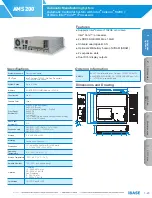
ELECTRICAL
SECTION 8
Page 39
DRESSTA
TD-25M EXTRA
BATTERY
7. Dry charged batteries may be placed in service immediately after activation. However, to insure
good performance these additional steps are recommended.
Check the specific gravity of all cells. Under good storage conditions, the electrolyte specific
gravity on activating a dry-charged battery will drop approximately 0.010 and temperature will
rise 4 [
°
C] to 5.6 [
°
C] within twenty minutes of filling the battery. A battery under these conditions
requires little boost charging. However, should the specific gravity drop 0.030 or more with
a corresponding increase in temperature, the negative plates have been oxidized and the
battery should be fully recharged before use. Also, the battery should be recharged if one
or more cells gas violently after the addition of electrolyte. After electrolyte is added, check the
open circuit terminal voltage of the battery. If battery reads less than 10 [V] this indicates
a reverse cell, an "open" circuit or a shorted cell, and the battery should be replaced.
19. TYPICAL CAUSE OF BATTERY FAILURE
1. Is the battery being used in the application for which it was designed.
2. Does the hold-down hardware fit the battery properly.
3. Has the battery required frequent water addition in one or more cells? Excessive water loss
in one cell may indicate a short. Excessive water loss in all cells may indicate overcharging,
a worn out battery, or both.
4. Is the electrolyte cloudy, discolored, or contaminated with foreign material? Cloudy electrolyte
can indicate active material shedding due to overcharge or vibration. Electrolyte contamination
can cause high self-discharge rates and poor performance.
5. Are alternate plates dark and light colored? In a charged cell, the positive plates should be dark
in color and the negative plates light. If all plates are very light, severe undercharging could be
indicated.
6. Is voltage regulator setting correct? A high voltage regulator setting can cause excessive
gassing and water loss, thermal runaway, and eventual damage to plates and separators. If the
voltage regulator setting is too low, the battery will be in constant state of discharge.
20. VISUAL INSPECTION OF BATTERY
a. Inspection Before Disassembly
The following will describe a procedure which could be used to make an internal examination
of a battery which has failed. First, the battery is fully charged: at least an attempt is made to fully
charge it. The specific gravity of the electrolyte in each cell is recorded. The battery open circuit
voltage is recorded. All cell voltages should be recorded. The battery is allowed to stand for three
days and the specific gravity readings are recorded a second time. An excessive specific gravity
drop (35 points) in one or more cells is an indication that shorts exist in those cells. If two adjacent
cells have gravity readings considerably lower than the others, it is a good indication that electrical
leakage exists between the two cells and is discharging them. If the container and/or cover
is cracked it could be due to abuse (an impact blow), freezing or the battery exploded.
High temperatures may permit the container to bulge.
Summary of Contents for TD-25M EXTRA
Page 1: ...SMTD25MEX07 1E SERVICE MANUAL TD 25M EXTRA SERIAL NUMBERS 75001 AND UP DRESSTA ...
Page 2: ......
Page 4: ......
Page 5: ...SECTION 1 INTRODUCTION ...
Page 6: ......
Page 8: ......
Page 25: ...SECTION 5 STEERING ...
Page 26: ......
Page 27: ...STEERING SECTION 5 DRESSTA TD 25M EXTRA CONTENTS GENERAL 1 DESCRIPTION 1 ...
Page 28: ......
Page 30: ......
Page 31: ...SECTION 6 COOLING SYSTEM ...
Page 32: ......
Page 34: ......
Page 49: ...SECTION 7 DRIVE TRAIN ...
Page 50: ......
Page 52: ......
Page 60: ......
Page 62: ......
Page 83: ...SECTION 7B HYDRAULIC TORQUE CONVERTER ...
Page 84: ......
Page 86: ......
Page 115: ...SECTION 7C TRANSMISSION ...
Page 116: ......
Page 208: ......
Page 209: ...SECTION 7E STEERING DRIVE ...
Page 210: ......
Page 212: ......
Page 251: ...SECTION 7F FINAL DRIVE ...
Page 252: ......
Page 254: ......
Page 272: ......
Page 273: ...SECTION 8 ELECTRICAL ...
Page 274: ......
Page 276: ......
Page 283: ...ELECTRICAL SECTION 8 Page 7 DRESSTA TD 25M EXTRA Fig 8 1 Wiring Diagram earlier version ...
Page 284: ......
Page 285: ......
Page 286: ...SECTION 8 Page 10 ELECTRICAL TD 25M EXTRA DRESSTA Fig 8 1A Wiring Diagram later version ...
Page 331: ...SECTION 9 FRAME ...
Page 332: ......
Page 334: ......
Page 336: ...SECTION 9 FRAME Page 2 TD 25M EXTRA DRESSTA GENERAL Fig 9 2 View of Frame ...
Page 339: ...SECTION 10 HYDRAULICS ...
Page 340: ......
Page 342: ......
Page 363: ...SECTION 10A PUMPS ...
Page 364: ......
Page 366: ......
Page 387: ...SECTION 10B VALVES ...
Page 388: ......
Page 390: ......
Page 412: ......
Page 413: ...SECTION 10C CYLINDERS ...
Page 414: ......
Page 416: ......
Page 449: ...SECTION 10E RESERVOIRS AND FILTERS ...
Page 450: ......
Page 452: ......
Page 459: ...SECTION 12 POWER ...
Page 460: ......
Page 462: ......
Page 478: ......
Page 479: ...SECTION 13 SUPERSTRUCTURE ...
Page 480: ......
Page 482: ......
Page 491: ...SECTION 14 SUSPENSION ...
Page 492: ......
Page 542: ......
Page 543: ...SECTION 15 TRACK OR WHEELS ...
Page 544: ......
Page 546: ......
Page 565: ...SECTION 17 MOUNTED EQUIPMENT ...
Page 566: ......
Page 568: ......
















































